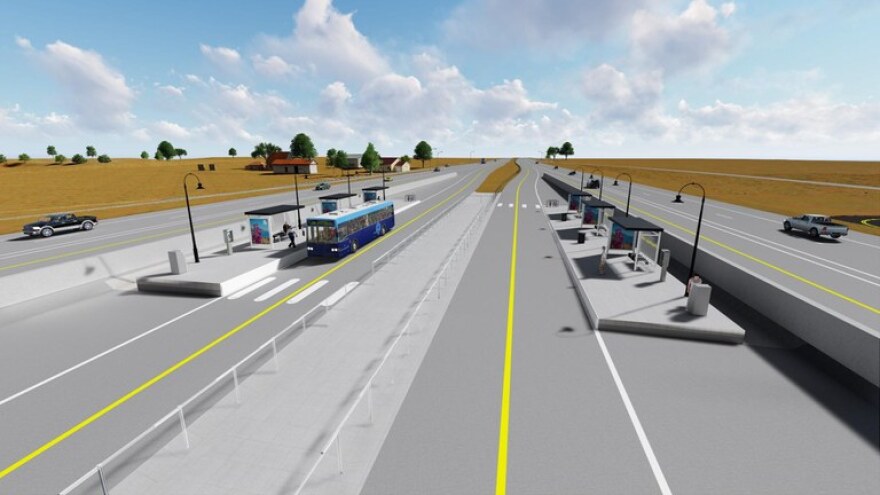When the dust settles on the massive I-25 expansion underway in Northern Colorado in 2023, a new kind of regional transit option will take center stage: bus stops in the middle of the highway.
With the help of federal coronavirus stimulus dollars, construction crews have broken ground on a $6 million mobility hub in Berthoud. The structure resembles a traditional bus station, but is set in the middle of the highway’s north and southbound lanes. Planners say it’s the first of its kind in the state.
The money comes from Congress’ second stimulus package, which passed in late December. In January, the state’s transportation commission approved more than $150 million in stimulus dollars for local road projects, including the Berthoud hub.
Colorado is expecting even more money for transit projects from President Joe Biden’s American Rescue Plan, which Congress passed in March. Those funds have yet to be dispersed.
Once complete, passengers will enter the Berthoud mobility hub from special tunnels dug underneath the highway, which connect to nearby parking lots.
Instead of exiting the highway, buses will then pick up those passengers directly from the centrally-located stops. The structures are designed to support bus services from local transit agencies, as well as CDOT’s growing line of statewide Bustang routes.
Similar stations are planned for interchanges in Loveland and Fort Collins, but regional transit managers are still securing funding.
KUNC’s Matt Bloom recently visited the Berthoud site to learn more.
Matt Bloom: We're out here off of the State Highway 56 exit to Berthoud in Northern Colorado. Across the street is kind of a mess of construction right now where crews are building a mobility hub. And that's what we're here to talk about with the mayor of Berthoud, Will Karspeck, and CDOT engineer Abra Geissler. Mayor, I want to start with you. How do mobility hubs work? What are they?
Will Karspeck: Depending on the design, the overall idea is just a central area for multimodal transportation. So, buses, your own vehicle, connecting to airports, bicycles. It's just a central meeting point for any type of transportation. It's one location where it comes together.
So for our interchange, the mobility hub is essentially a bus station where the bus will be able to drive on I-25 like usual. But instead of pulling off the interchange to pick up passengers, it'll merge on to the center of the interstate and have its own special stop. Passengers can go underneath I-25 through a pedestrian tunnel we’re building and walk up into the middle of I-25 and access that bus. So it's essentially a way where the bus can stay on I-25, which minimizes any kind of delay and also is much safer than having large public buses constantly entering and exiting the interstate.
Abra, is this a unique project for you and CDOT? Do you have other mobility hubs across the state? And if not, how is this different?
Abra Geissler: There are definitely other mobility hubs across the state, but this one and the other mobility hub at Kendall Parkway in Loveland that's getting constructed with the I-25 project as well, they're going to be the first median-loaded bus stations, which is really important. Like the mayor said, because it increases safety a lot where the bus isn't having to navigate across the general purpose lanes out of the express lane and on the on- and off-ramps. Those buses will be able to stay in the new express lane, then merge into the median and right back into that express lane. So, it’s much safer. And that was a big priority for us when we were designing this project.

Who do you envision using this the most?
Karspeck: Well, for one, I think residents of the Berthoud area. Where we're standing right now is going to be another massive development called Wilson Ranch, which will be around 4,000 residential units and some commercials. So roughly 8,000 people will live right here. So if we can get a shuttle out from our traditional Berthoud downtown area plus Wilson Ranch, I'd say that's the primary users for this hub. There are likely going to be others from Johnstown or other cities to this location. But I'd say it's primarily Berthoud residents. So I'm very excited.
I'm curious what your thoughts are on what this project in particular says about our region right now and the needs that it has.
Karspeck: We're exploding. Our population is growing exponentially. So I think this is a very smart move on behalf of the state. It's really a strategic kind of a pivot, essentially, to not only build more lanes for vehicles, but also to look at other modes of transportation that are more environmentally friendly and ultimately, I think more fiscally responsible.
Geissler: Yeah, I agree. I think with the Baby Boomer generation getting older and some millennials not showing as strong an interest in driving all the time, the pivot is now and that time has come. So we're responding very well to that. And just the collaboration with the northern Front Range communities on this has been really great and really the main reason why this is happening.
This conversation is part of KUNC’s Colorado Edition for May 6. You can find the full episode here.



